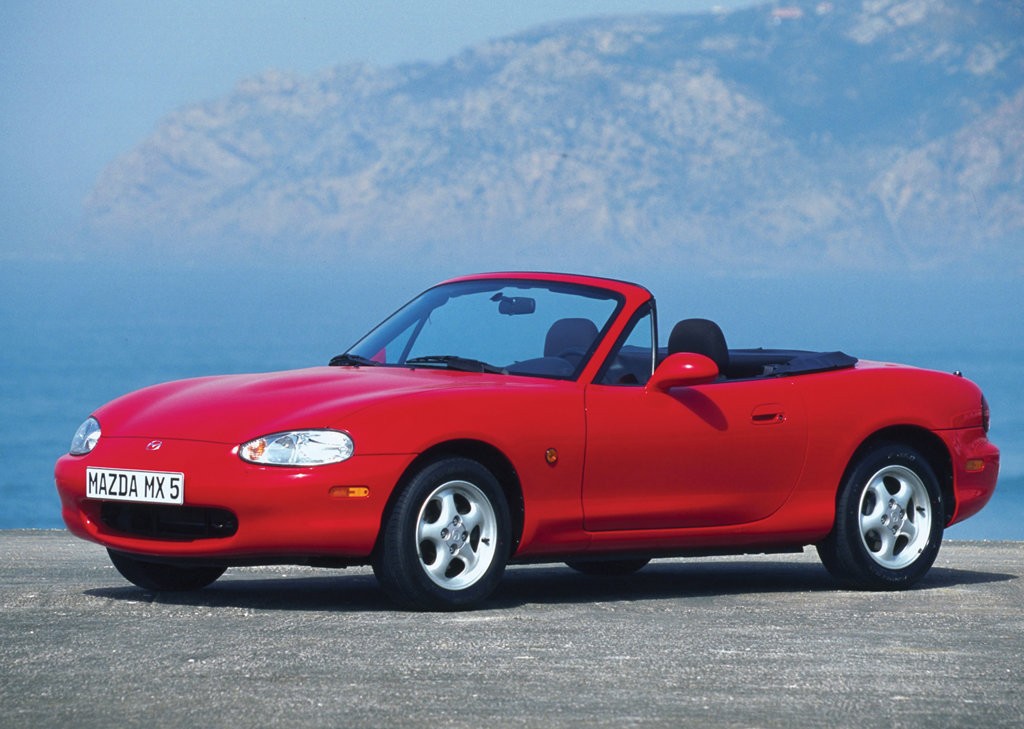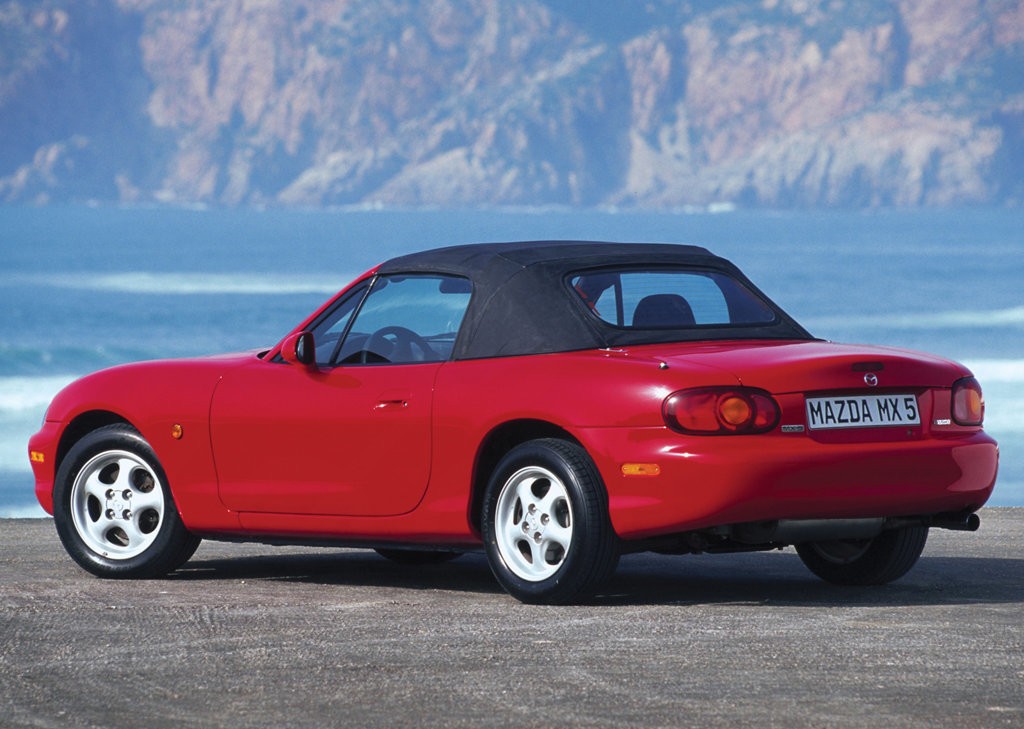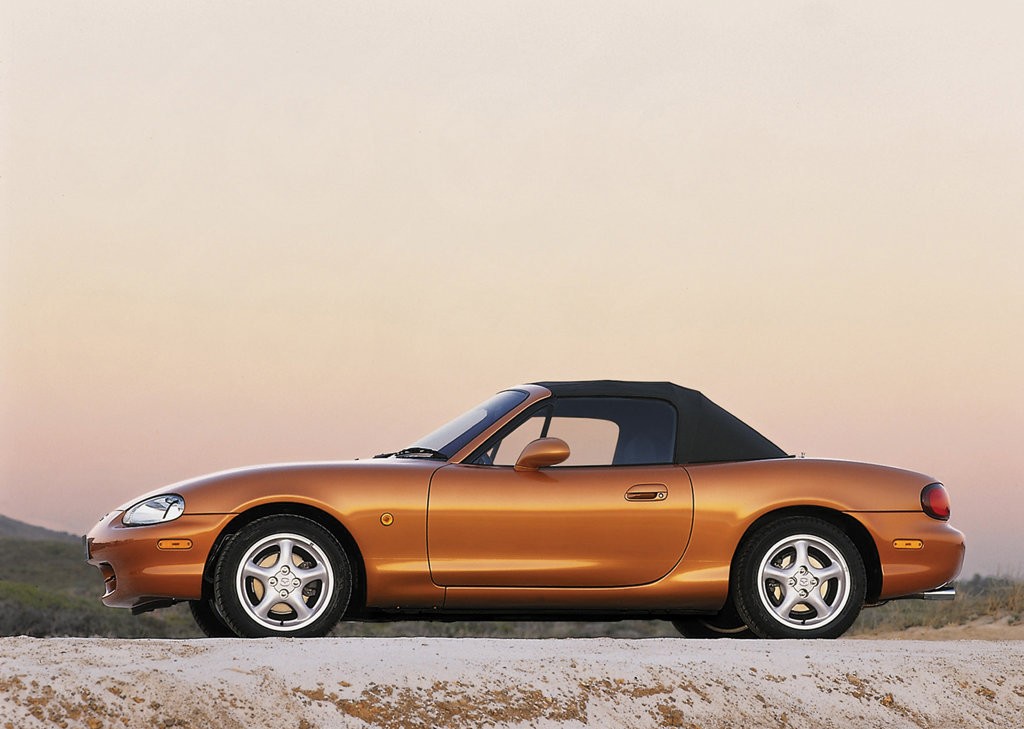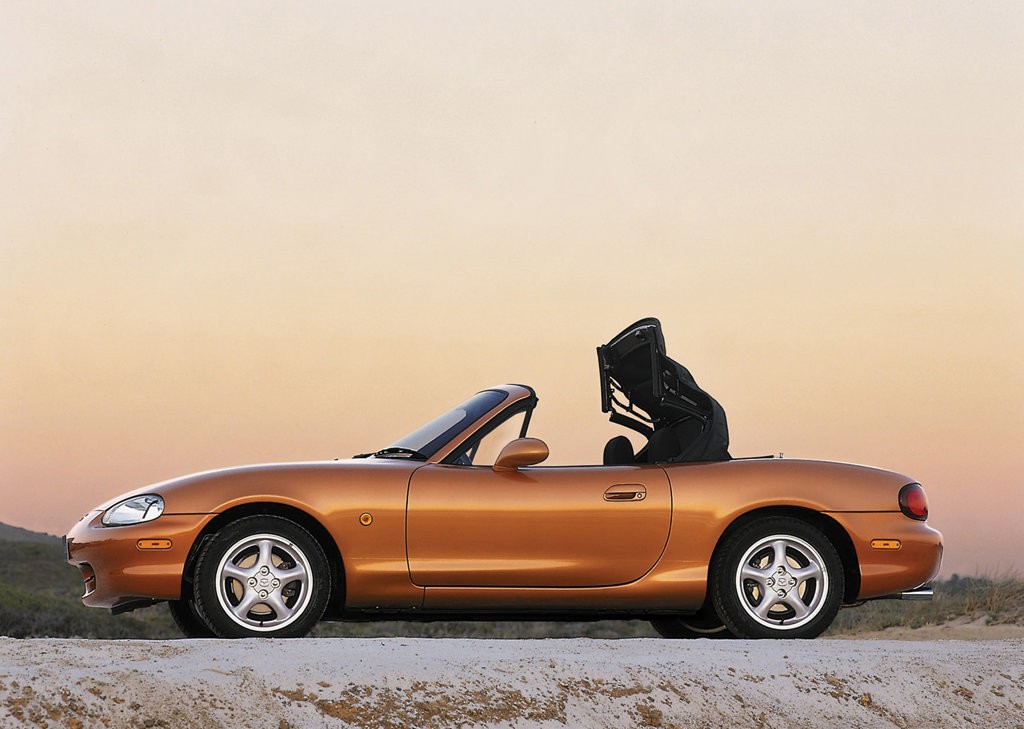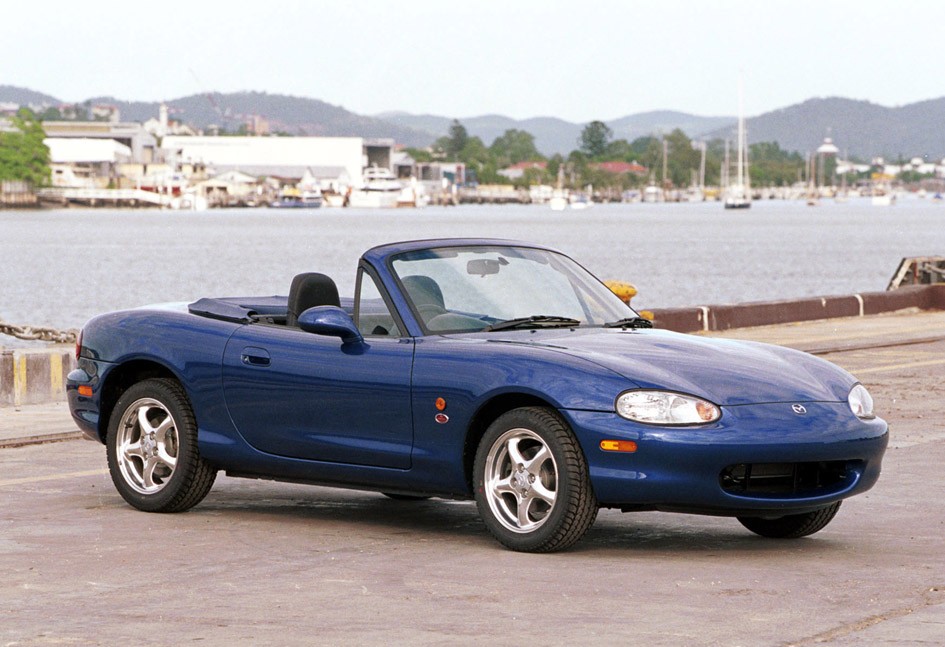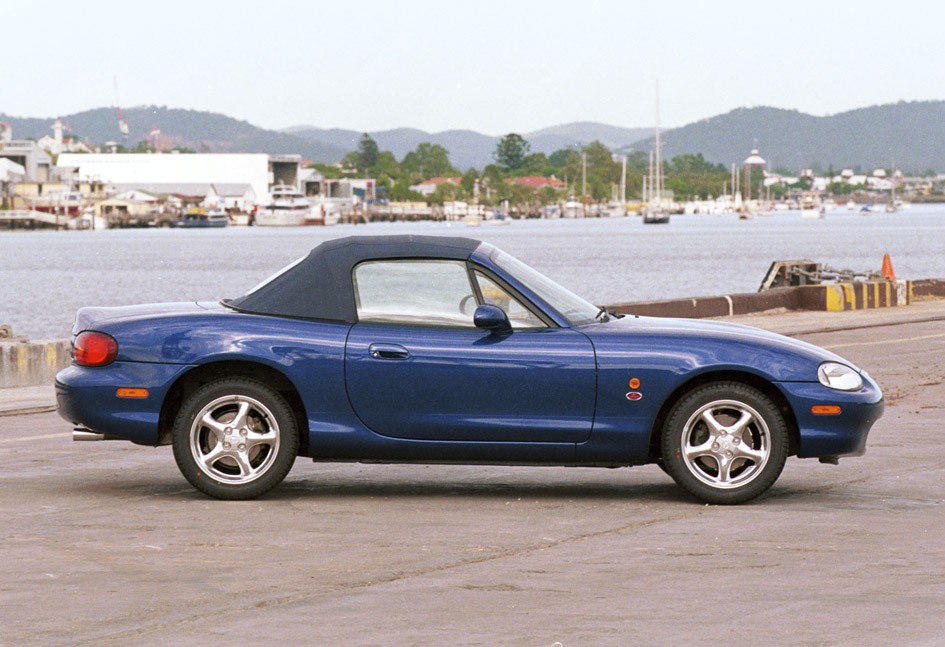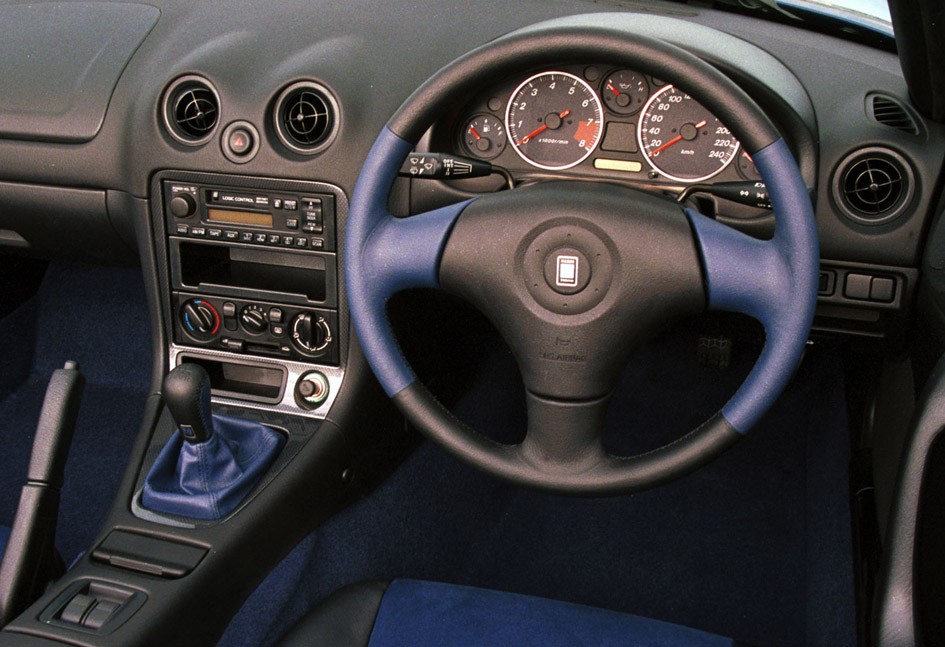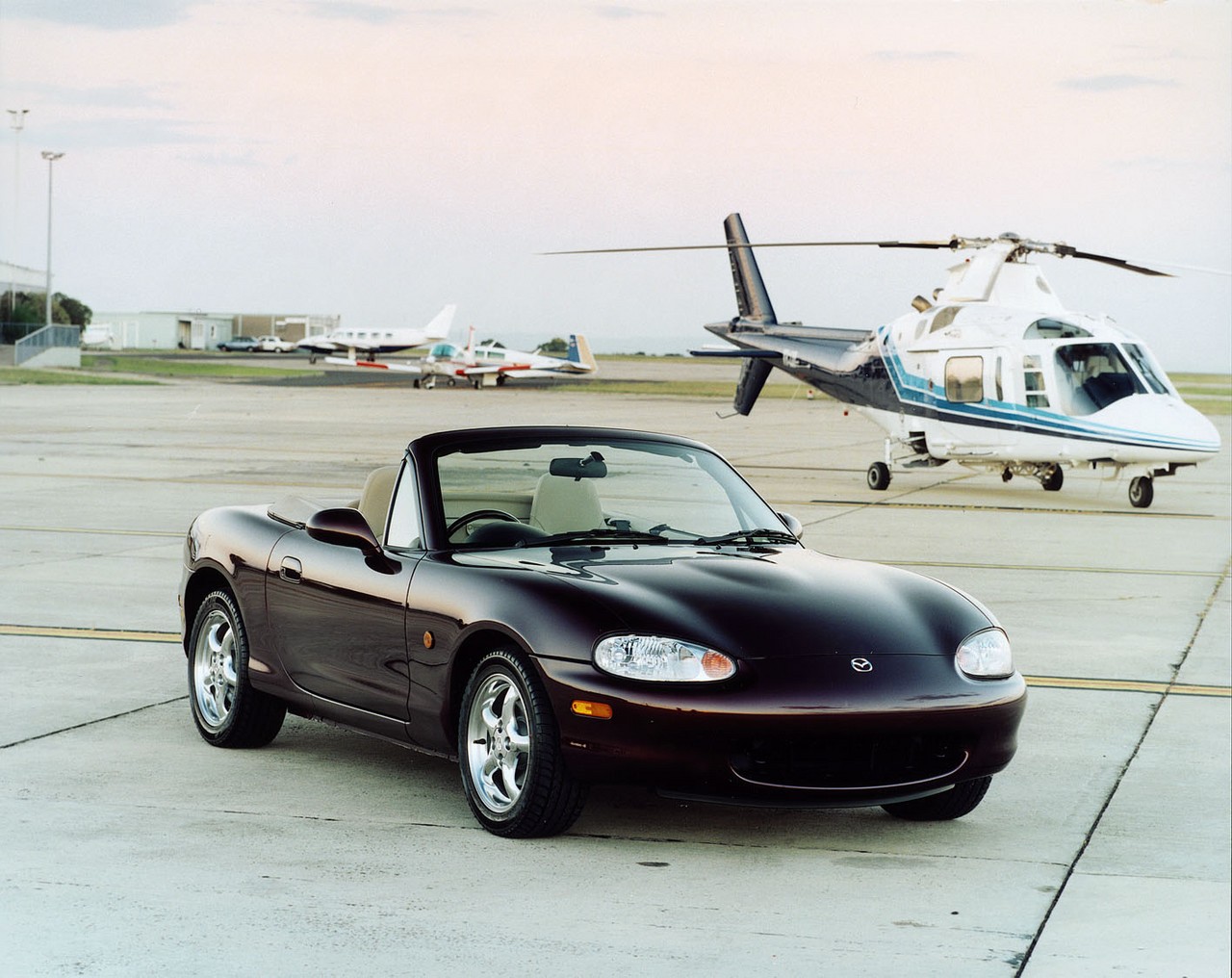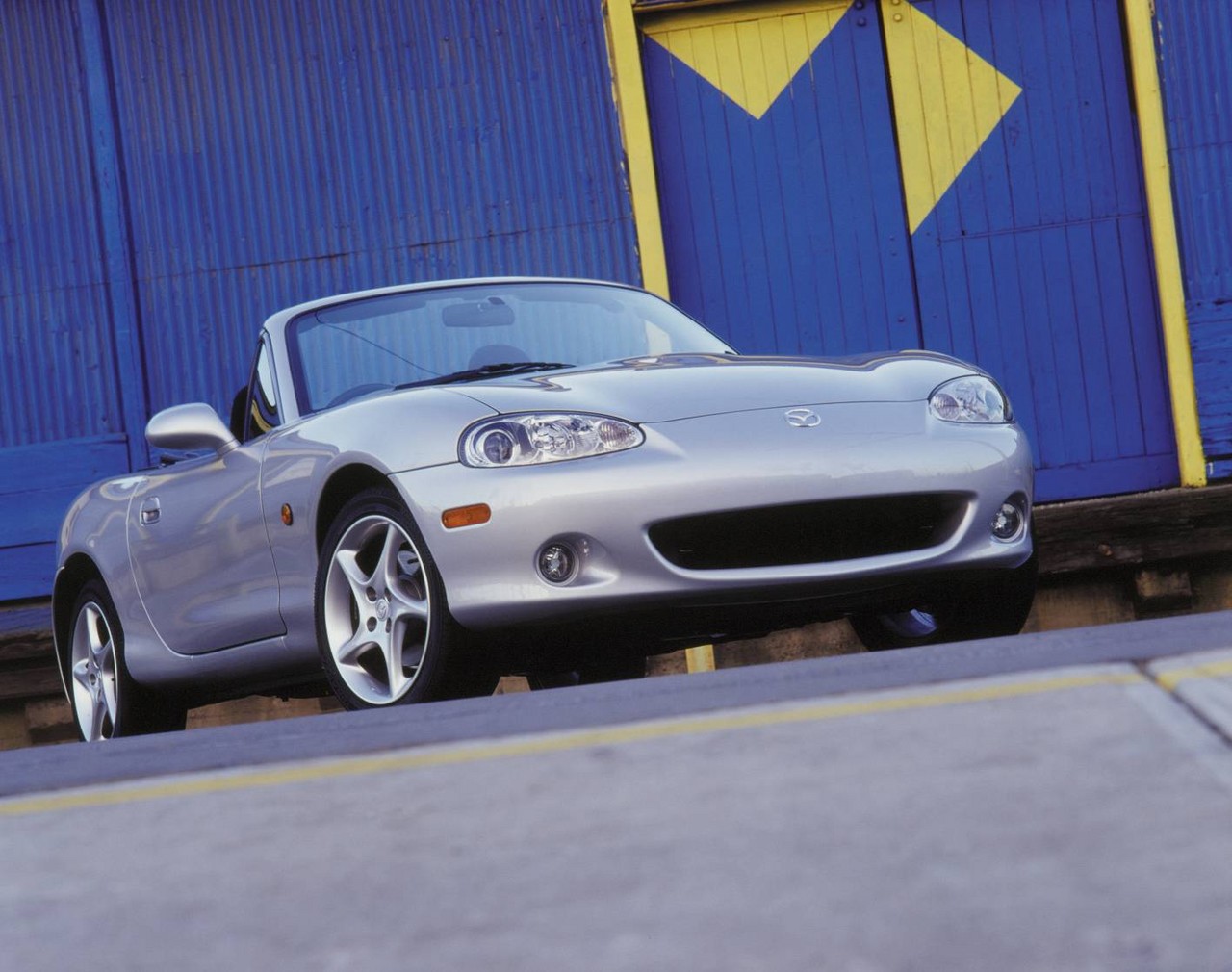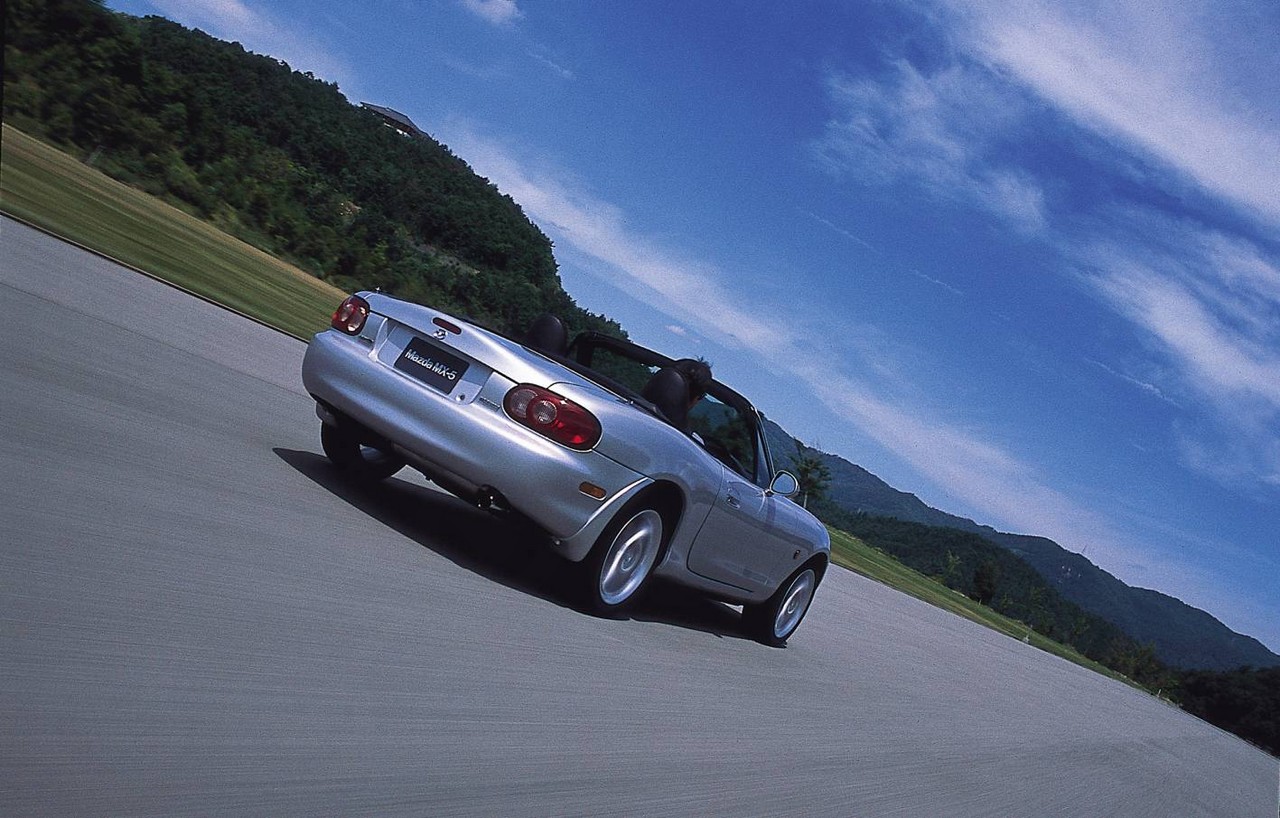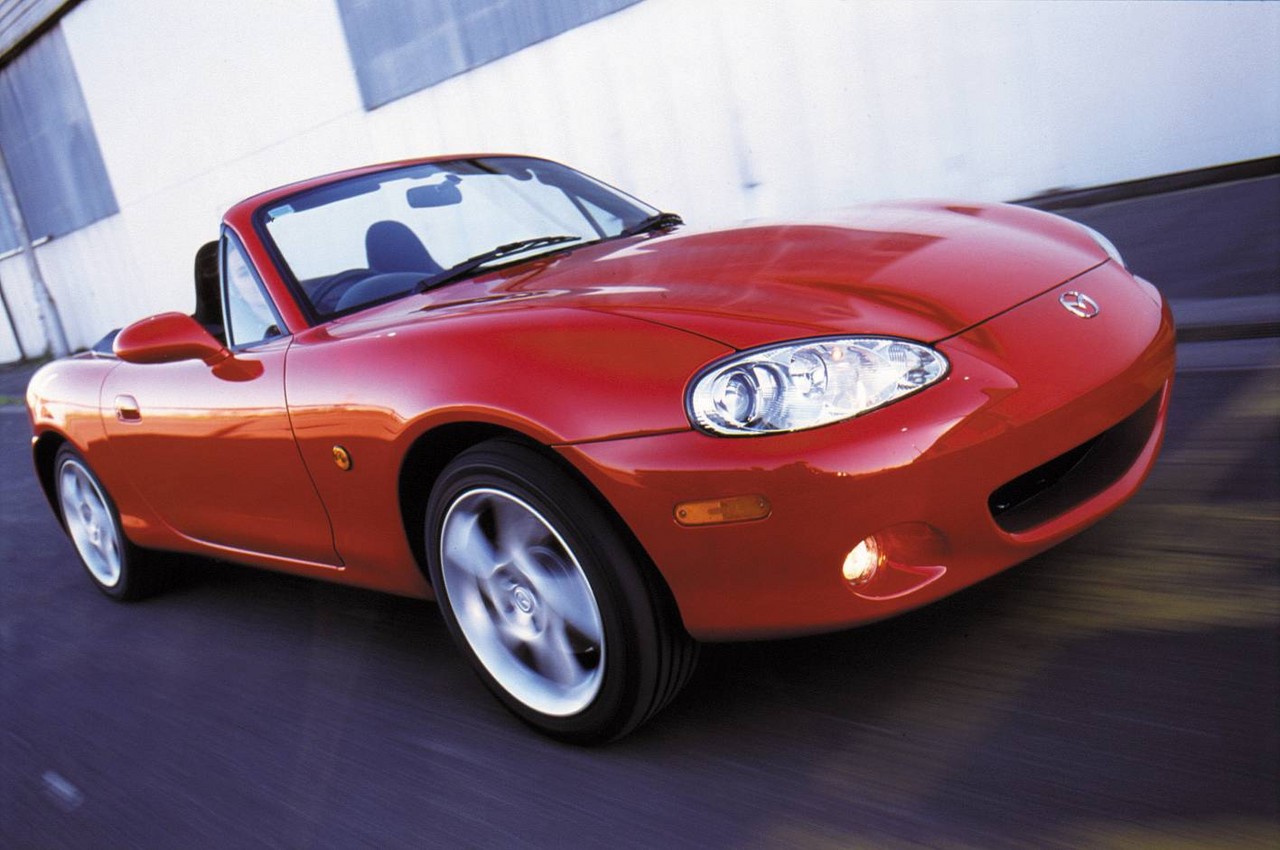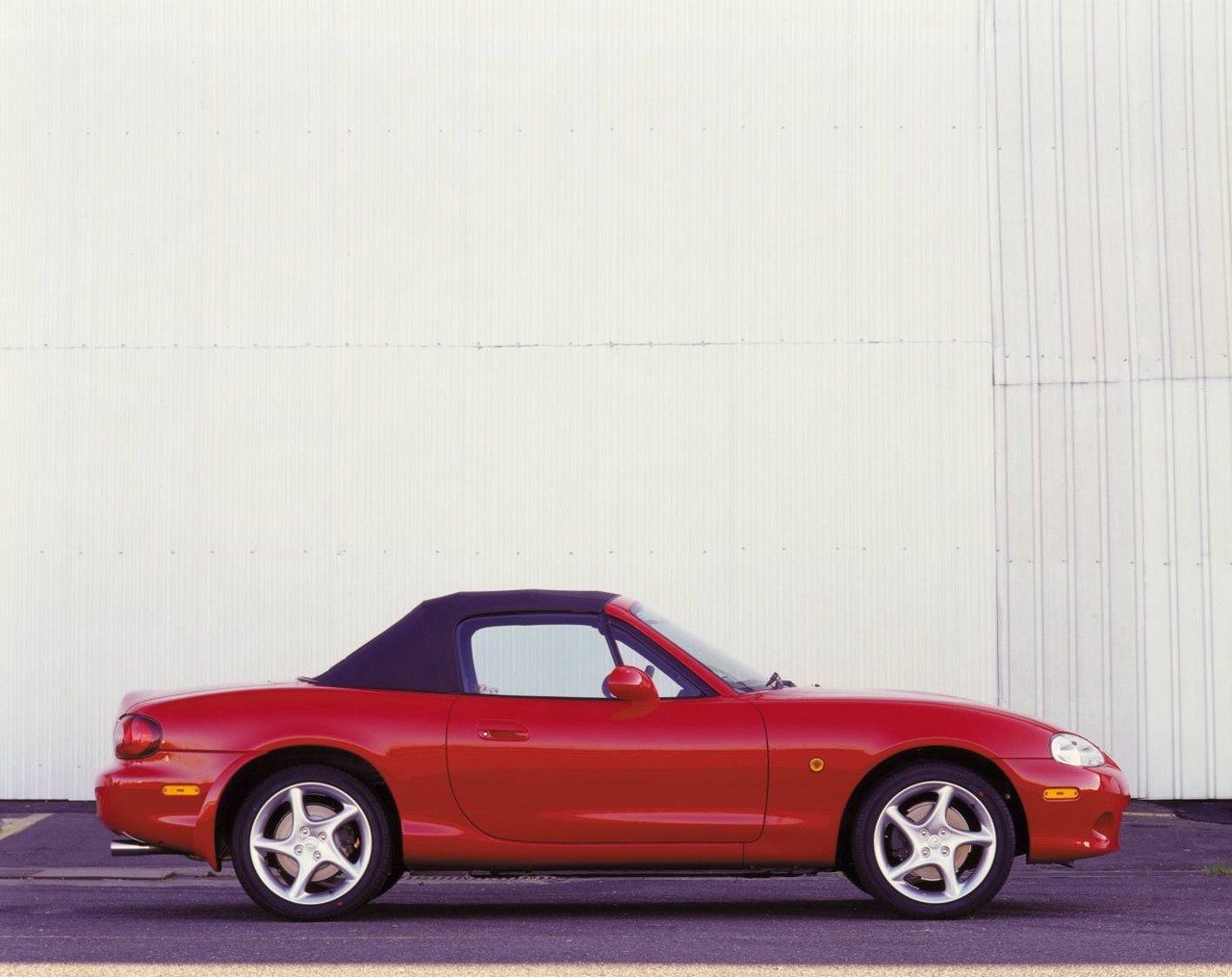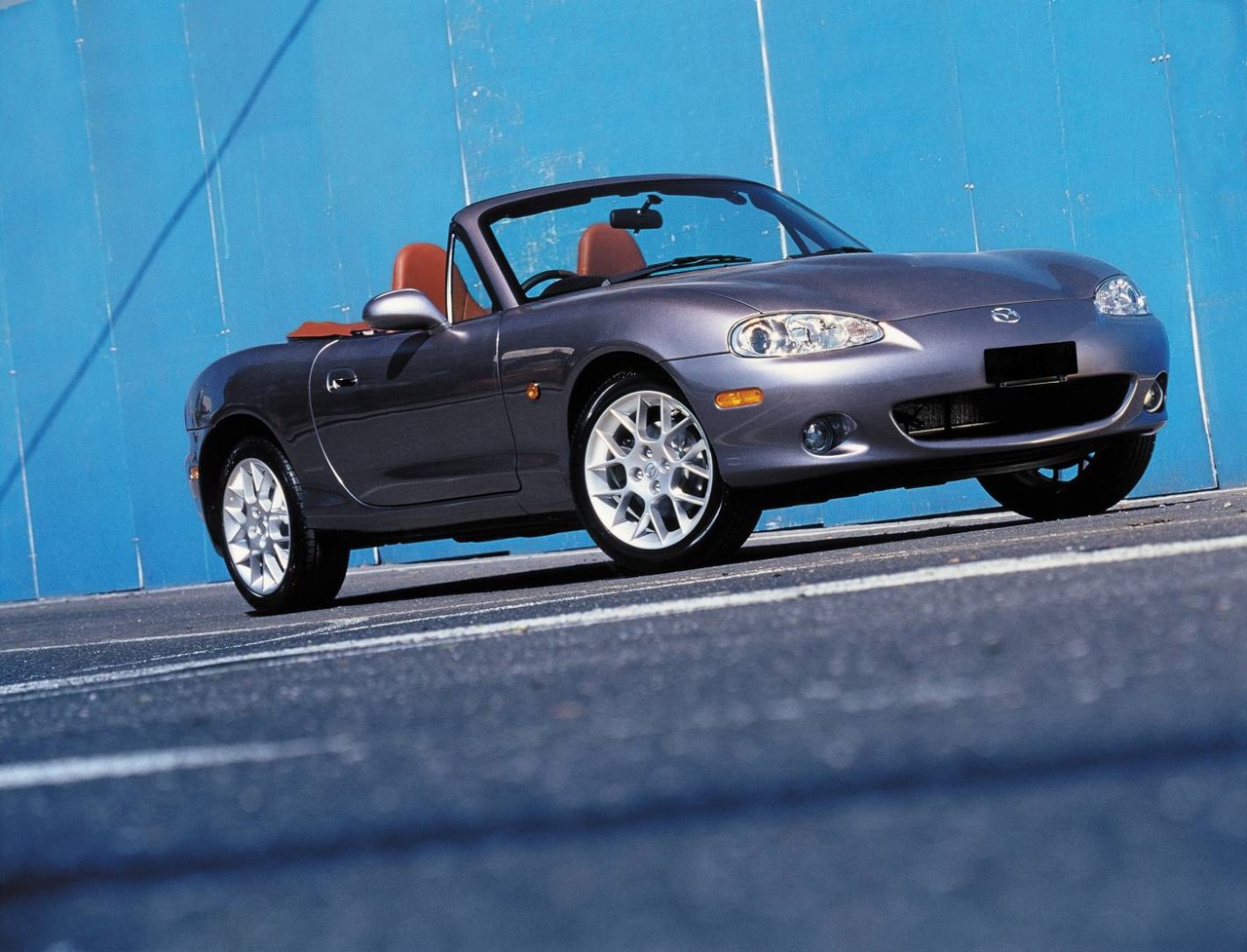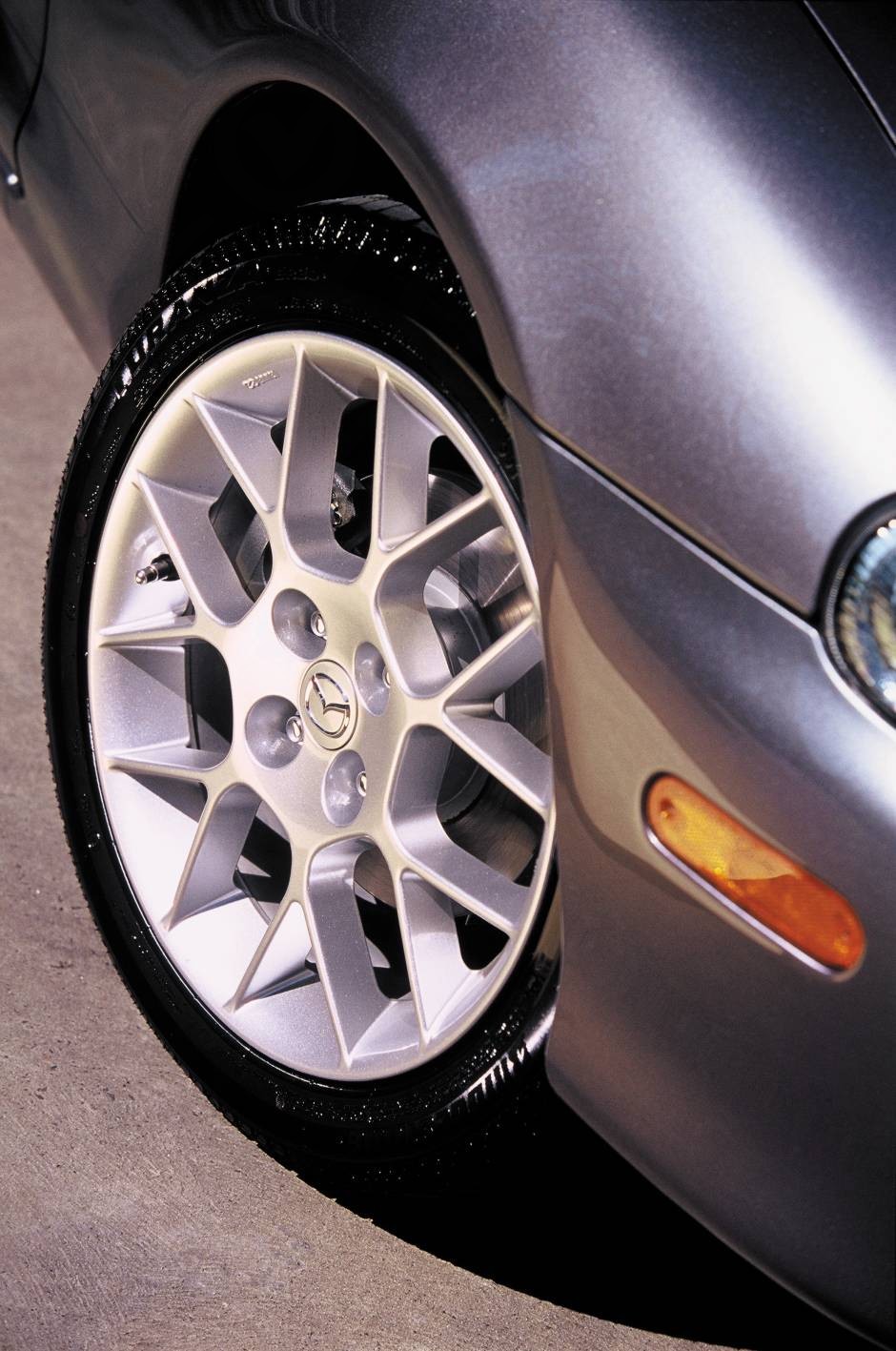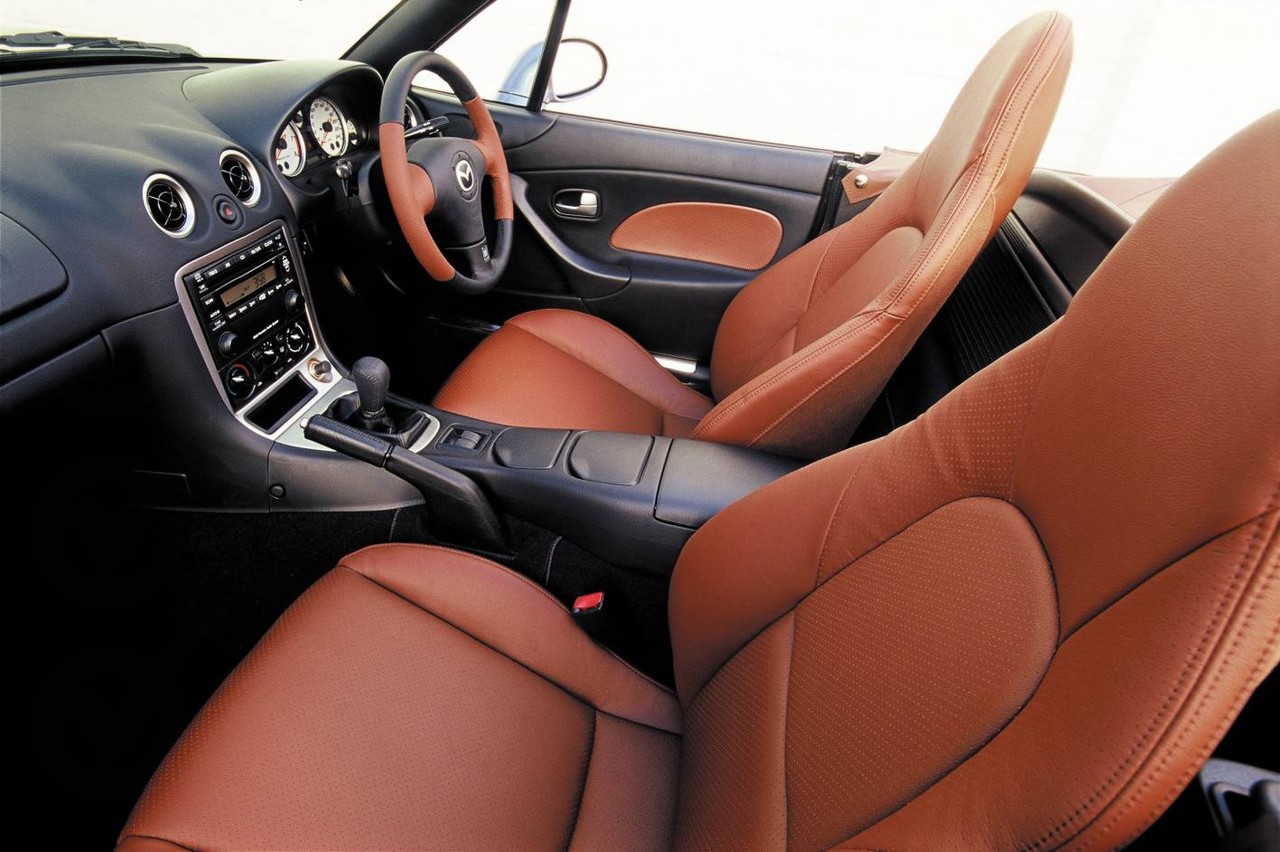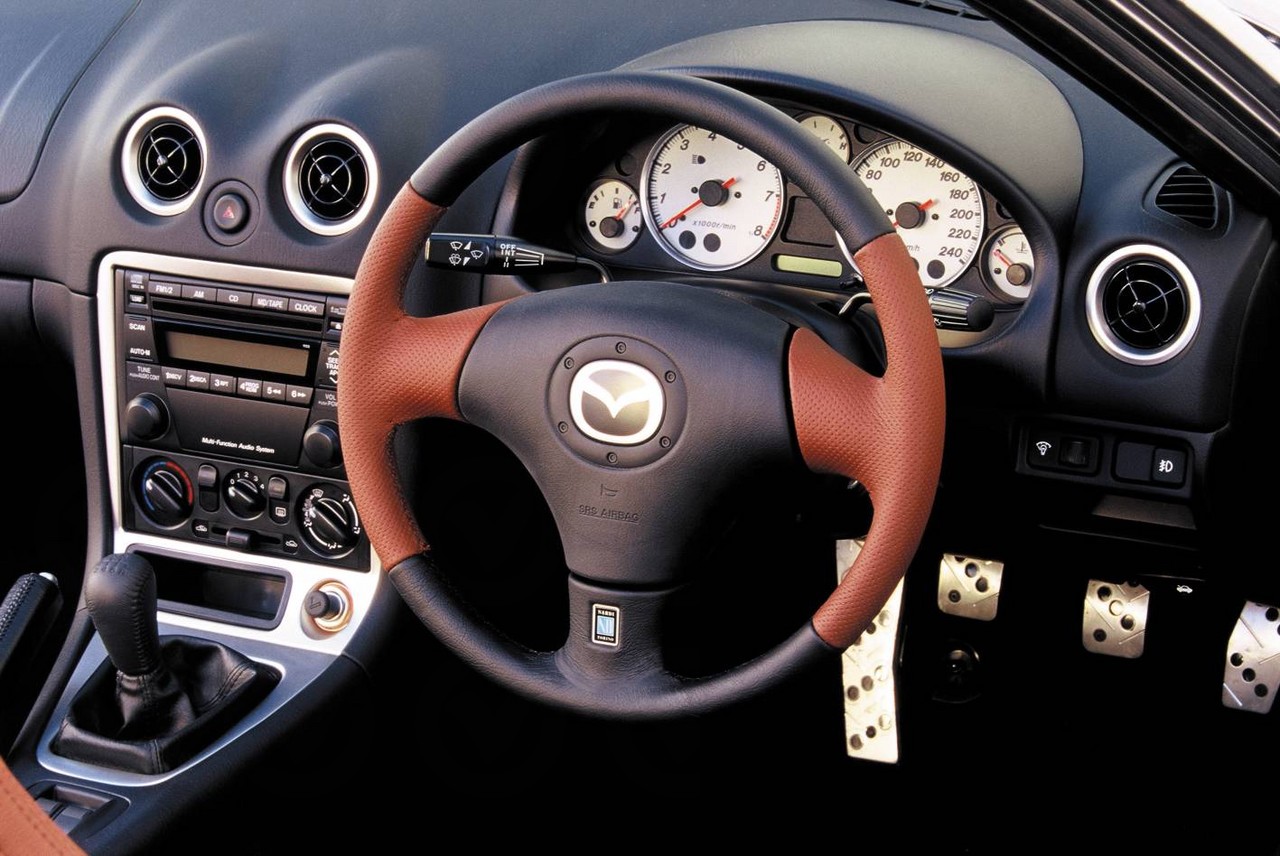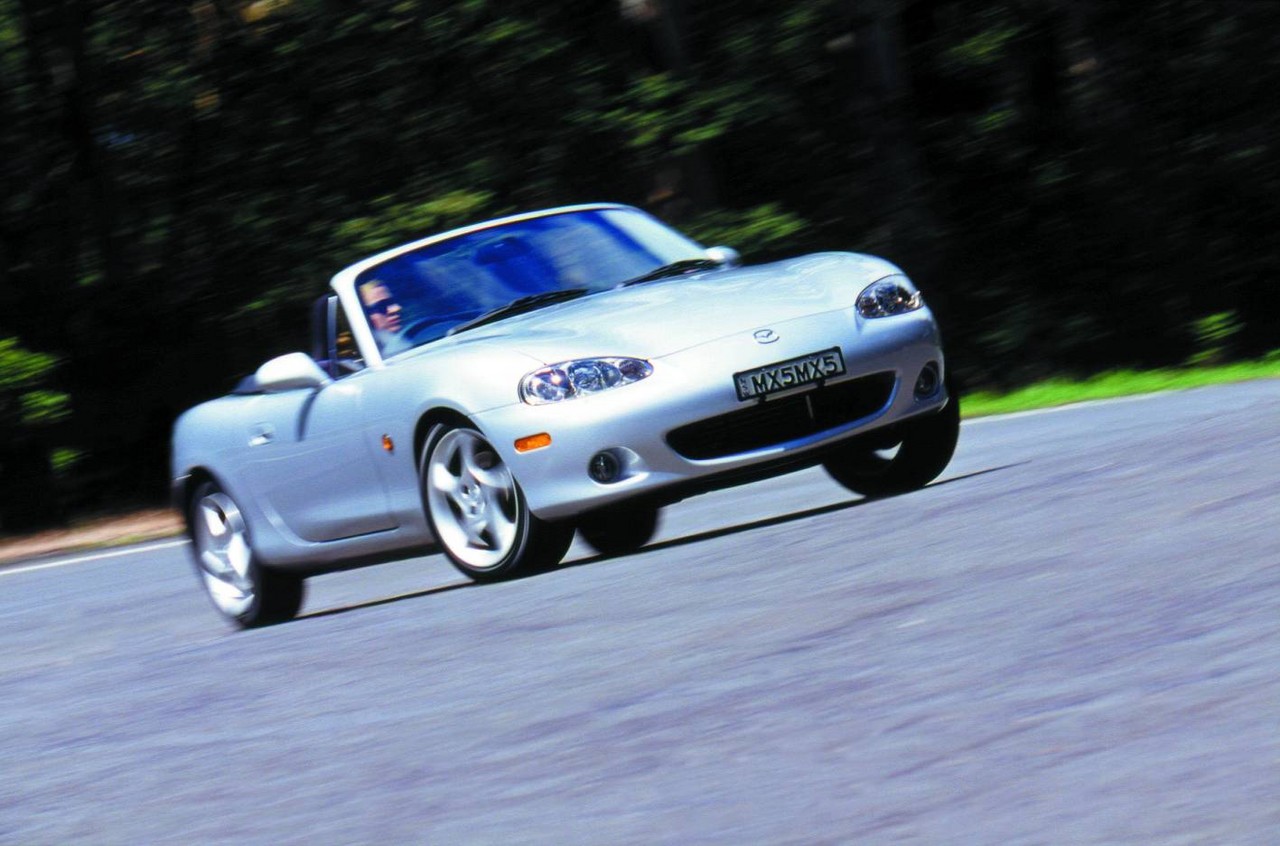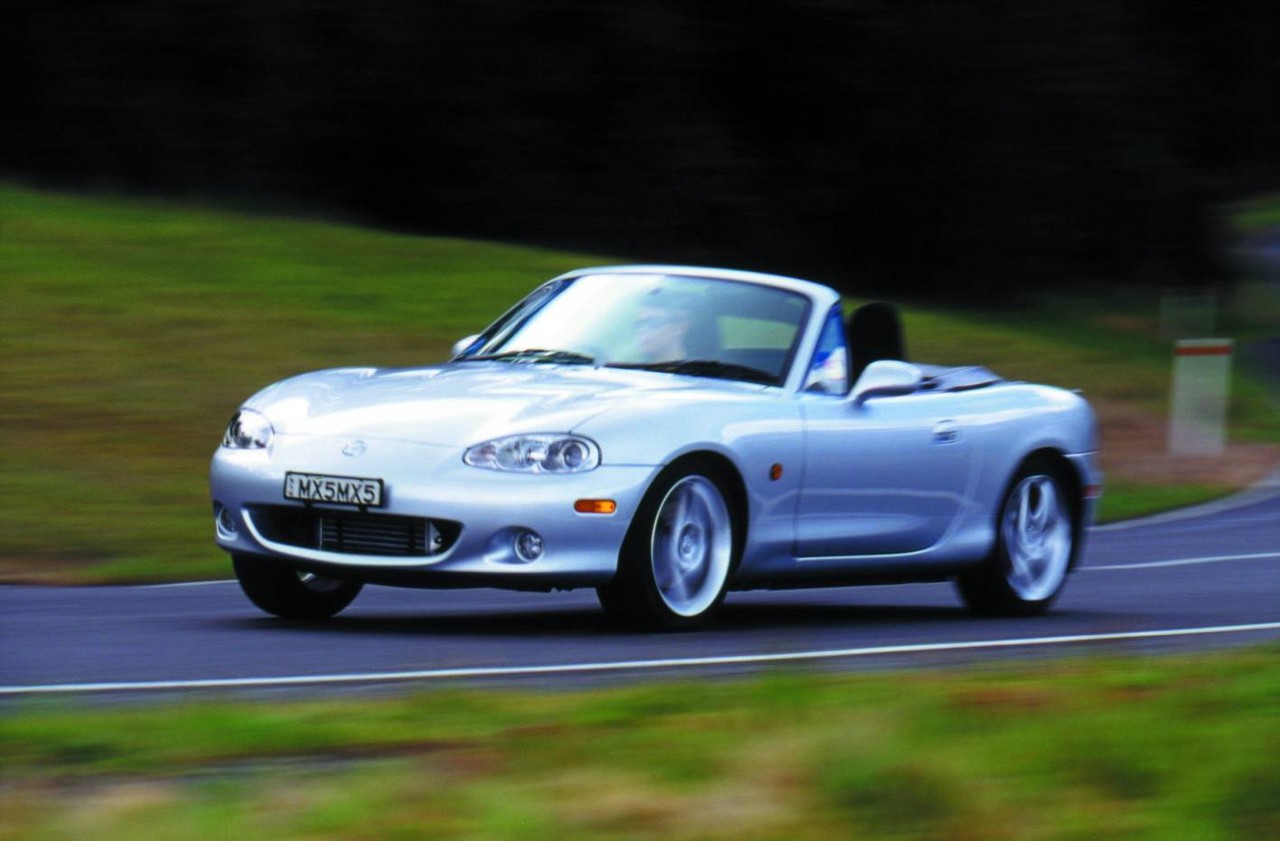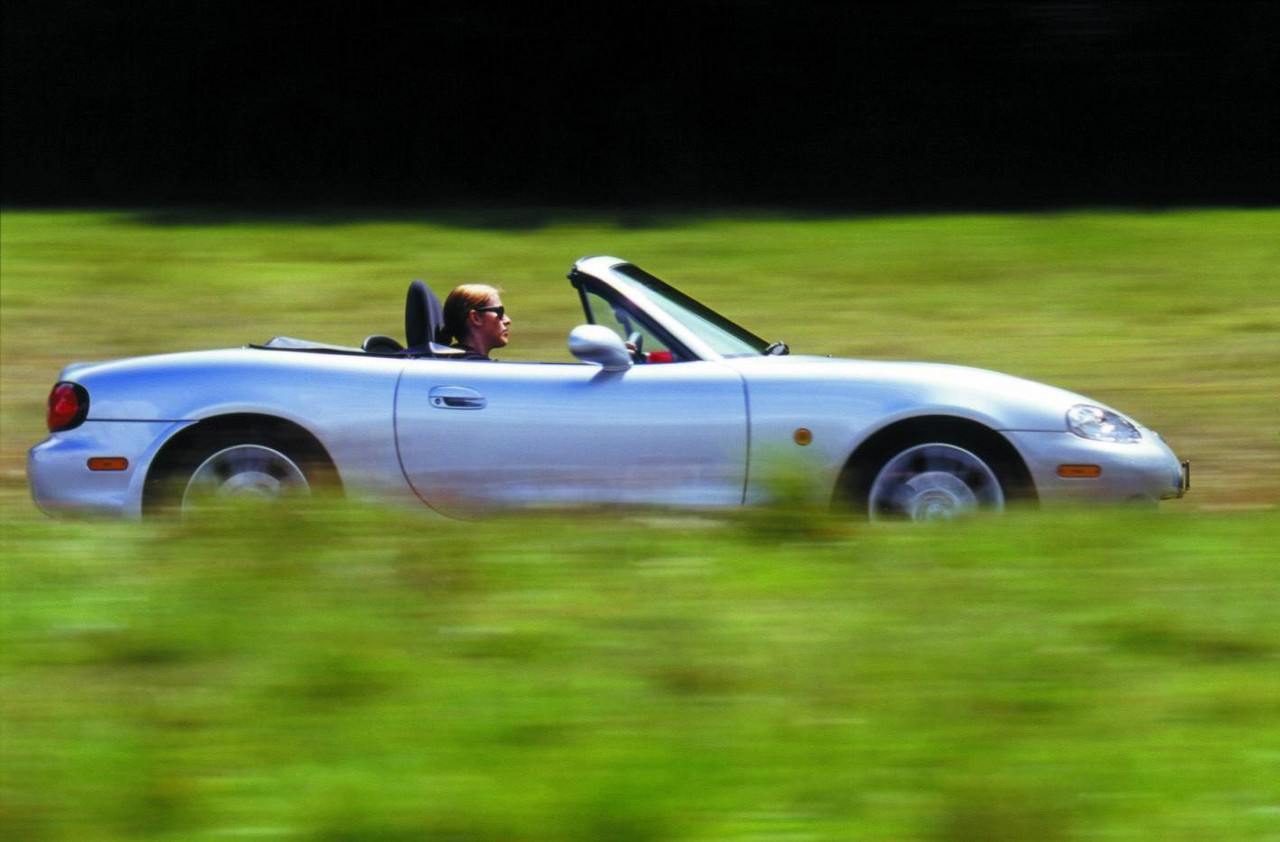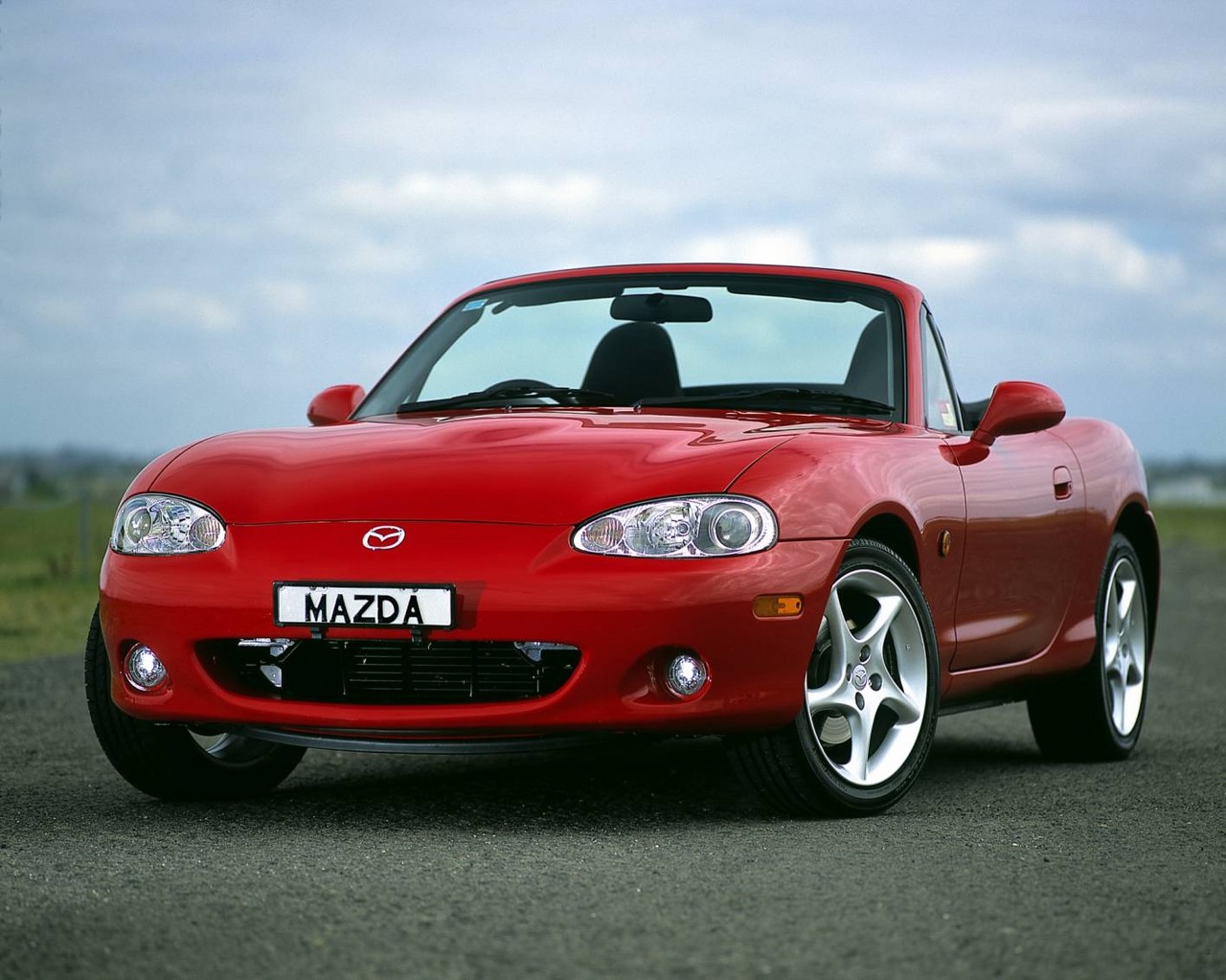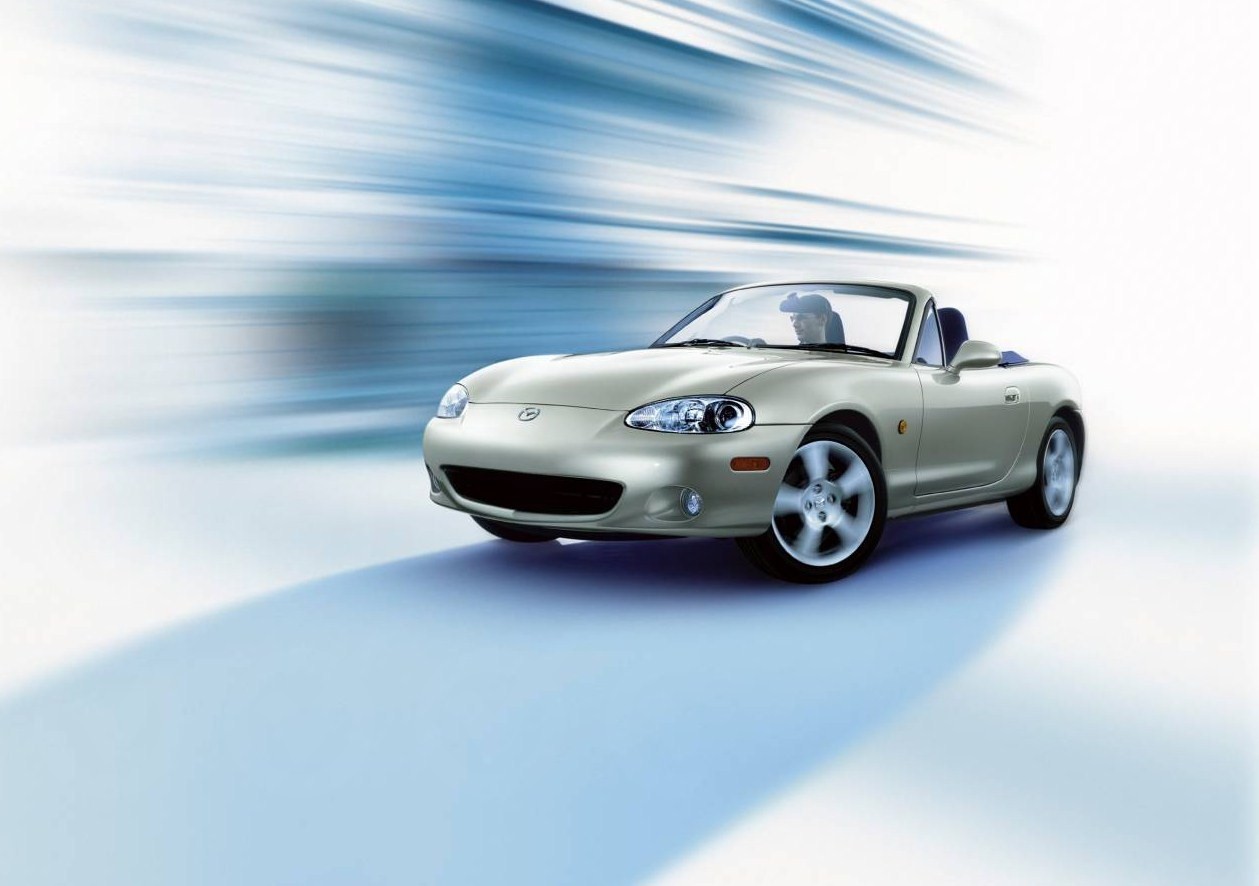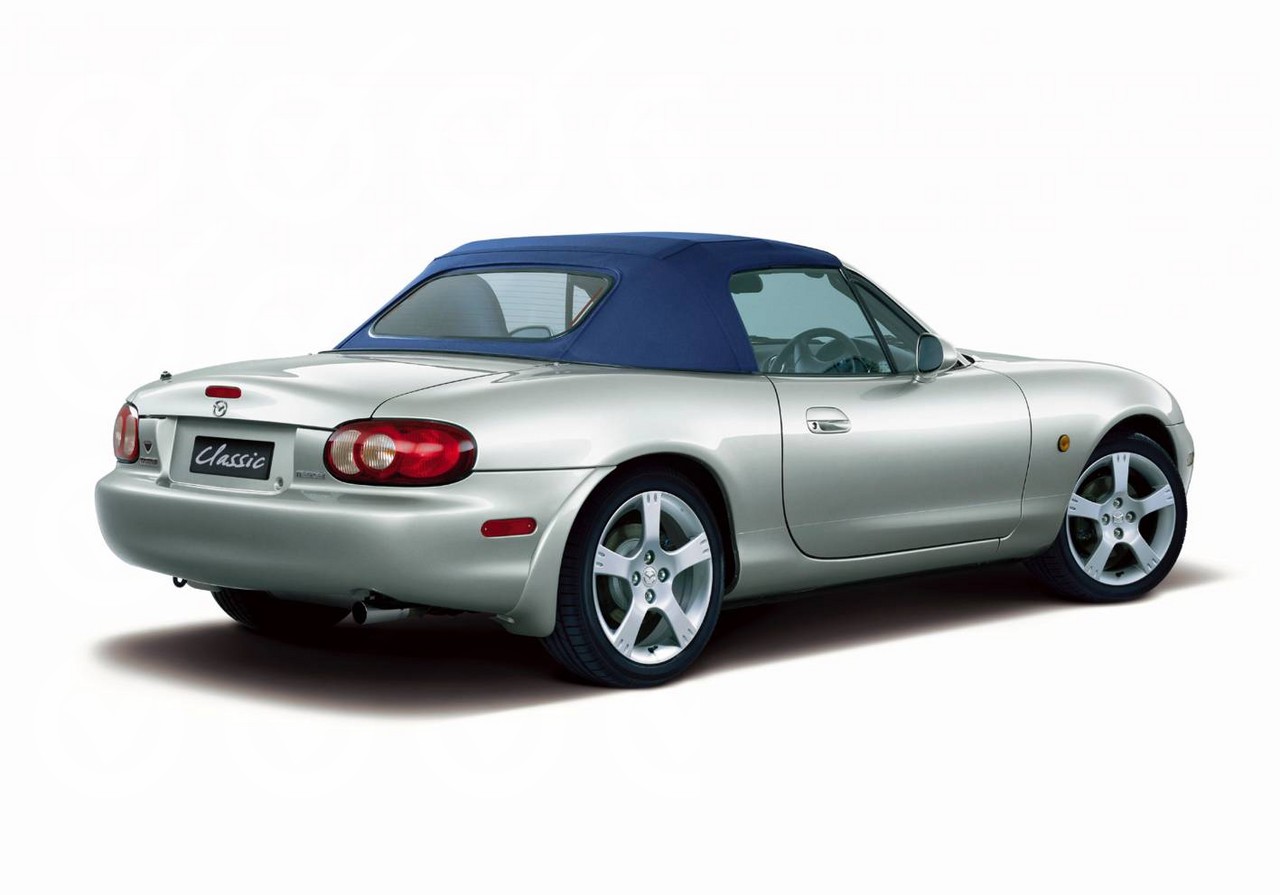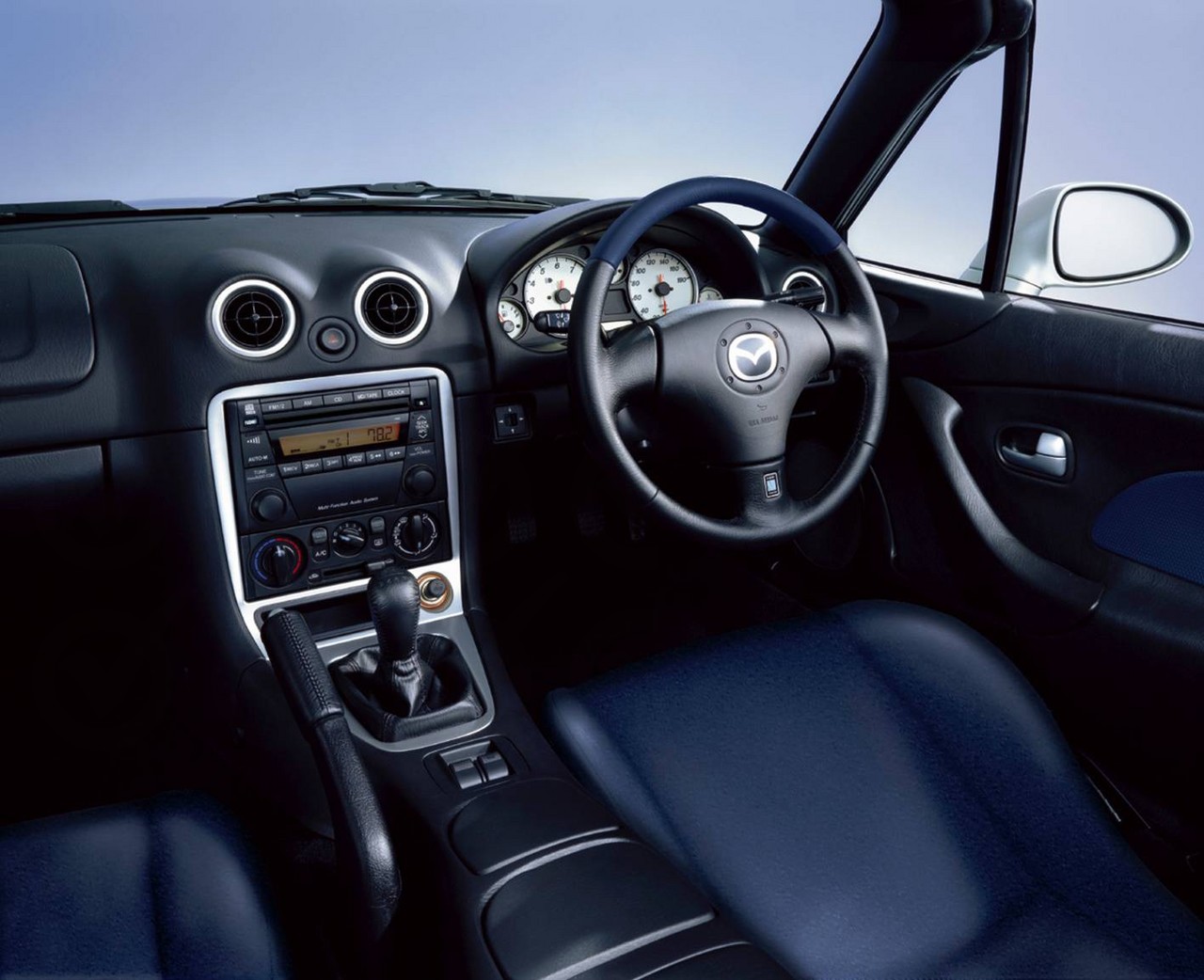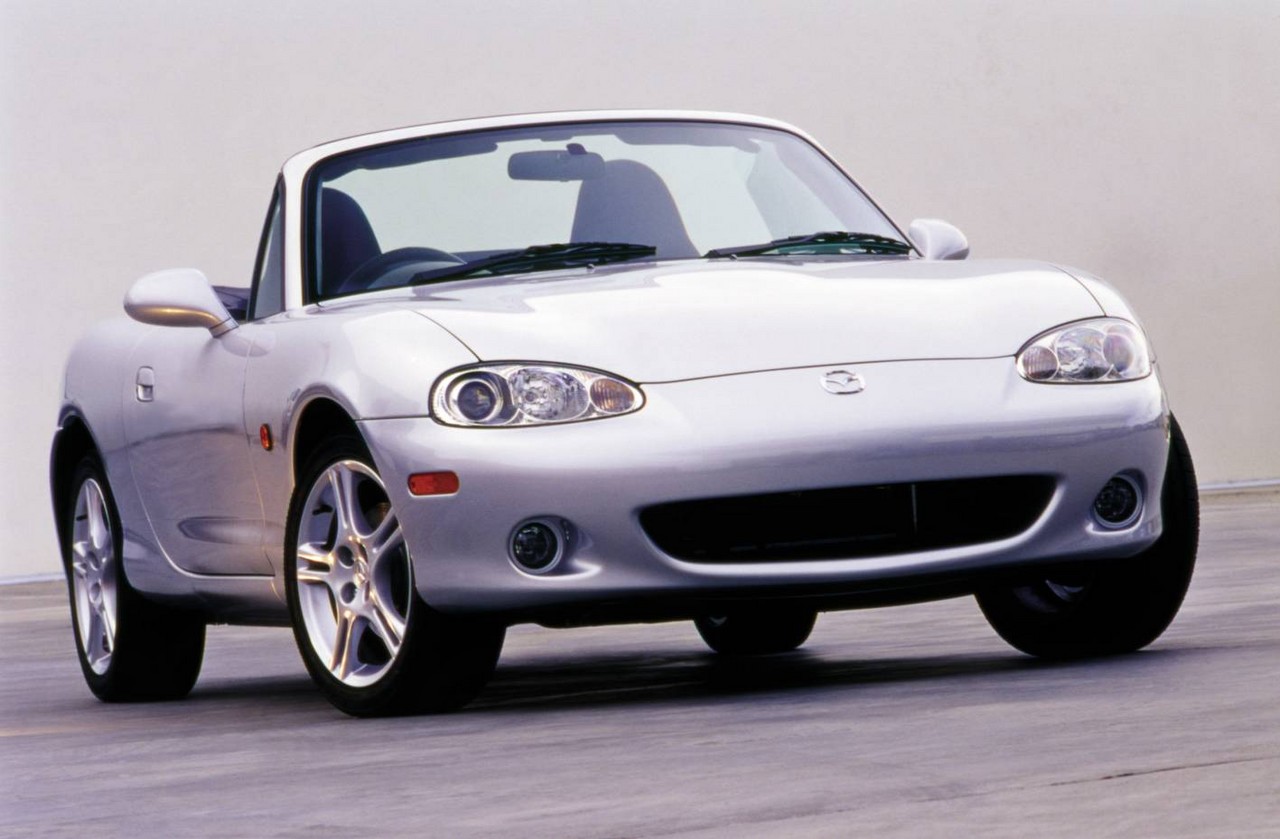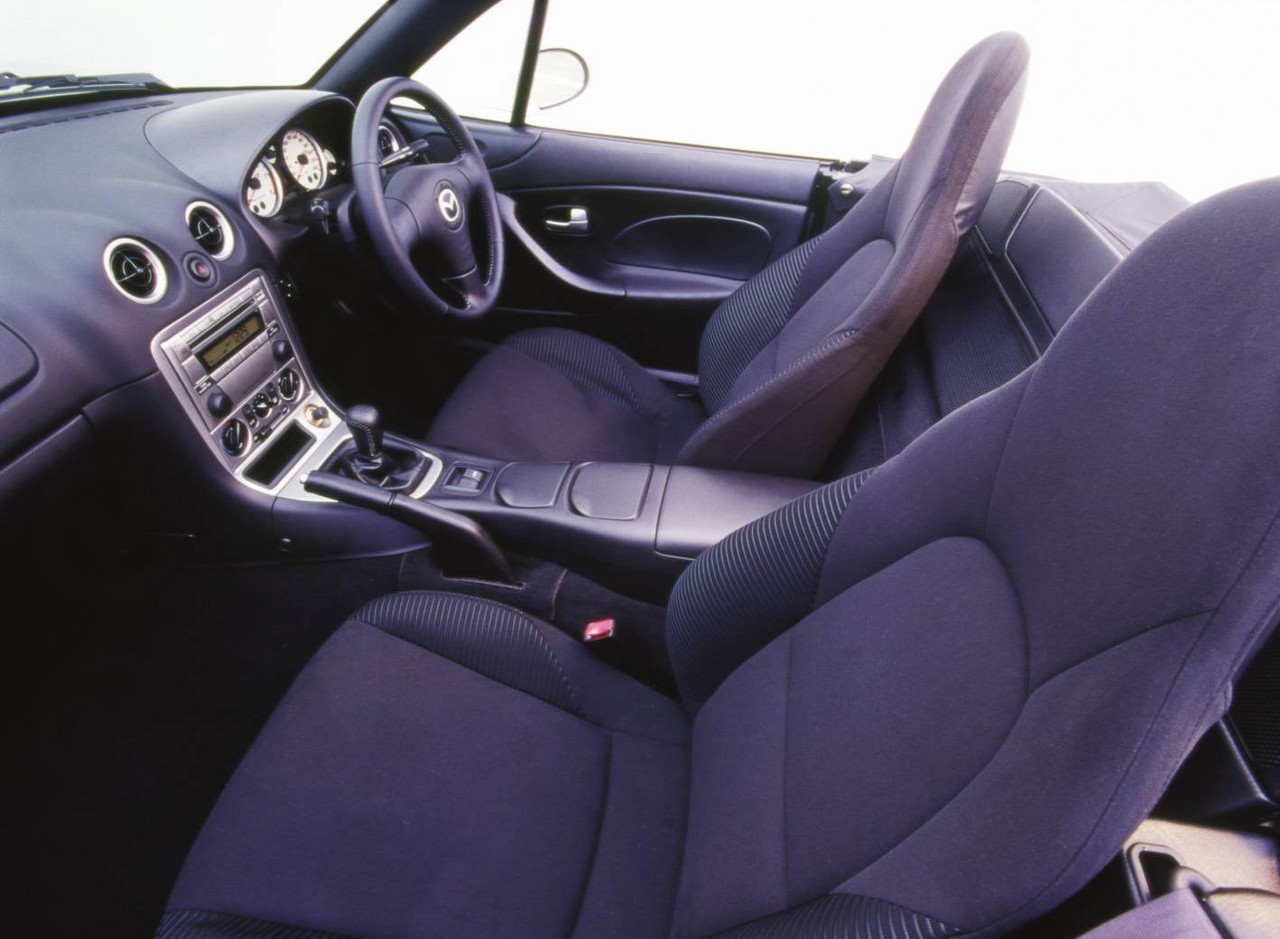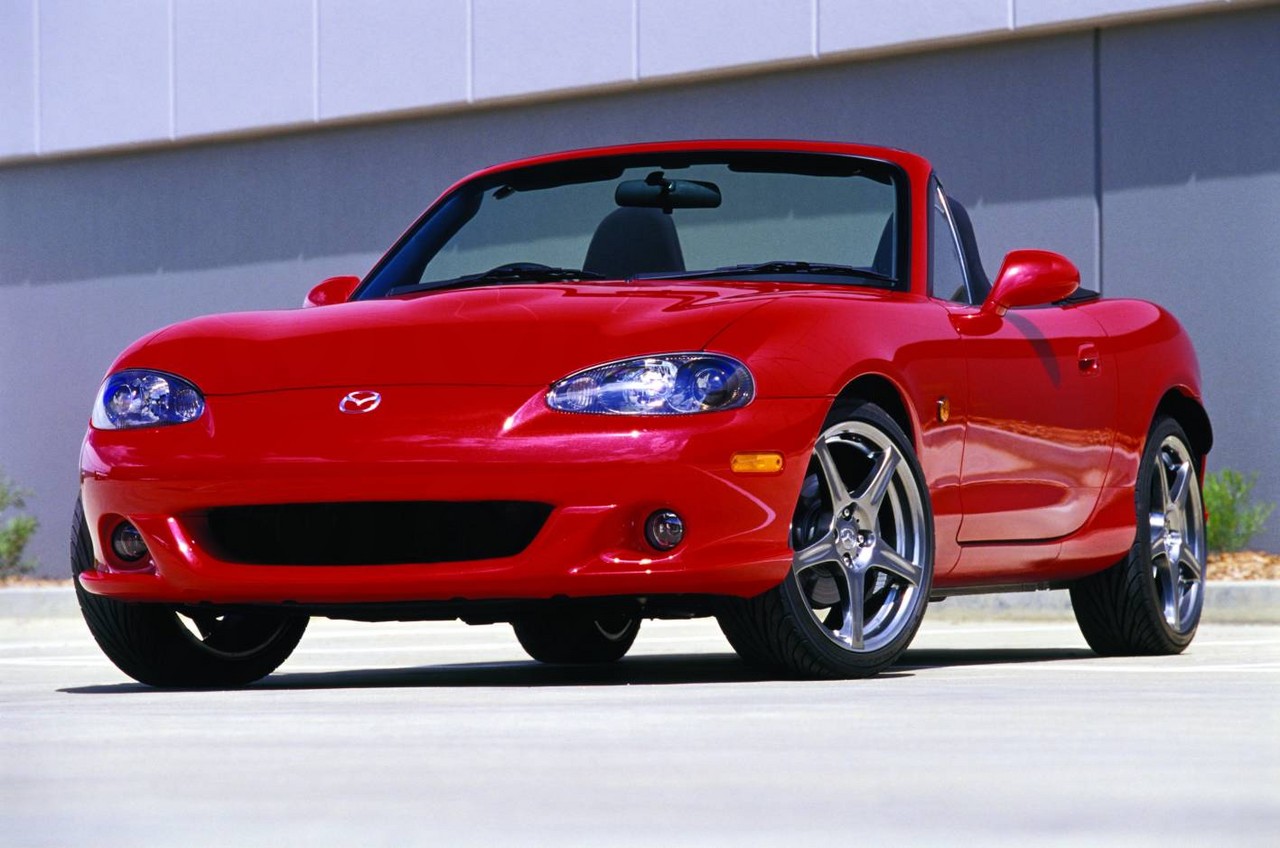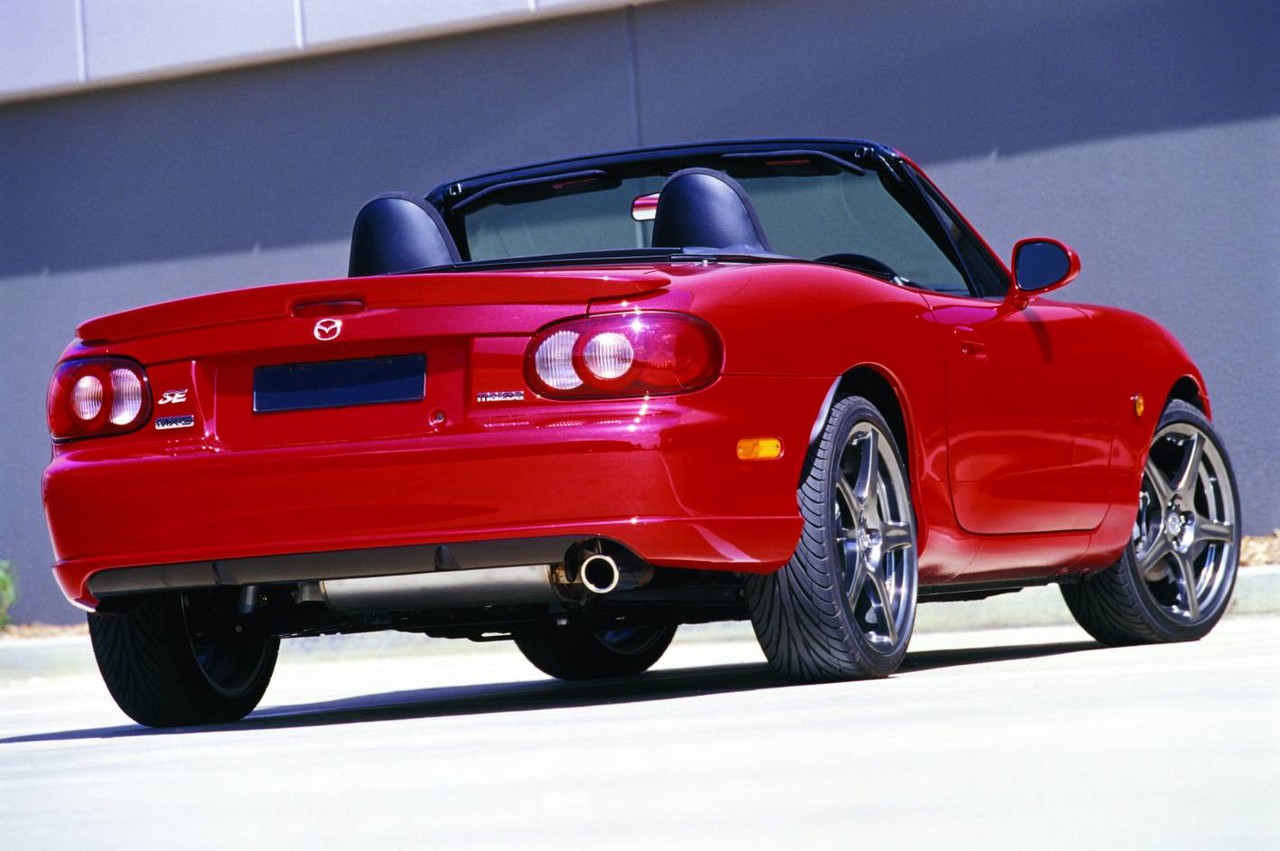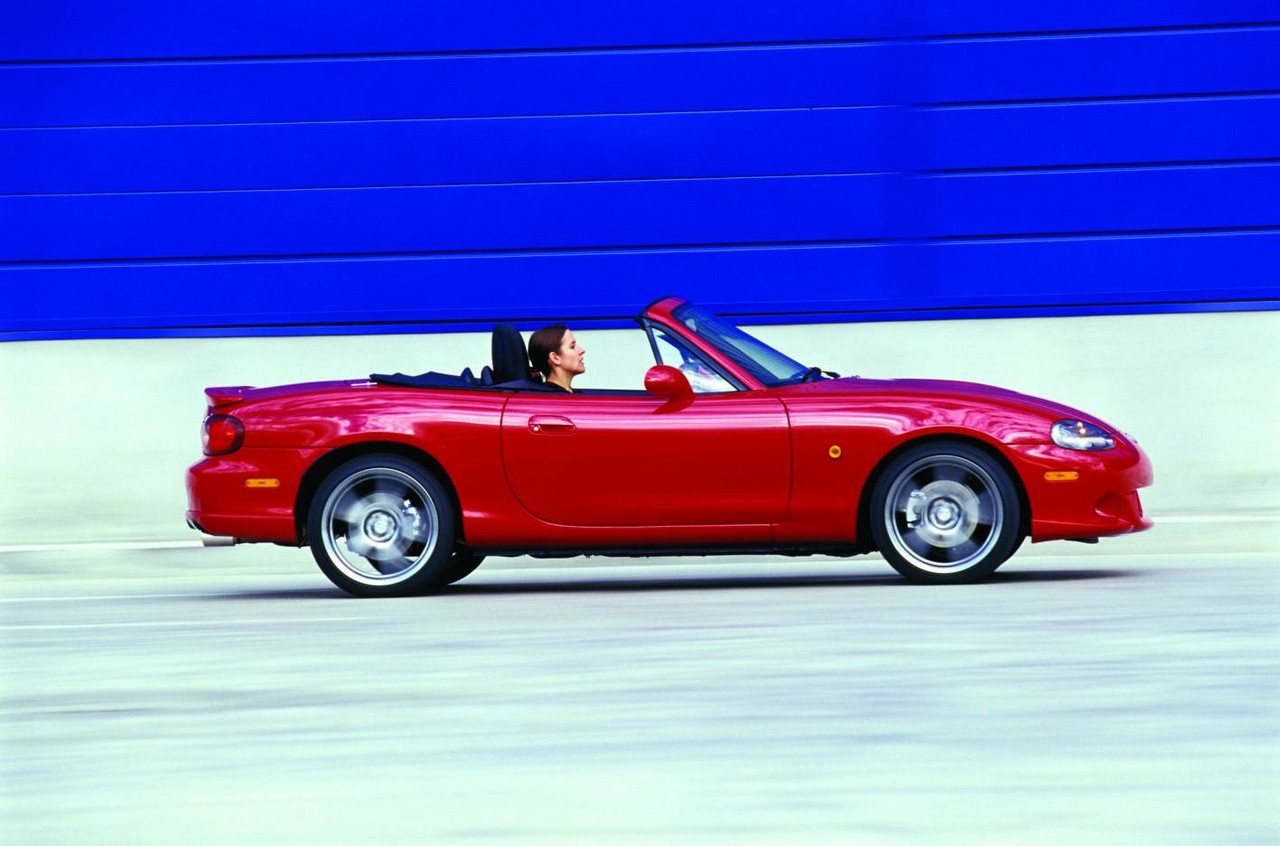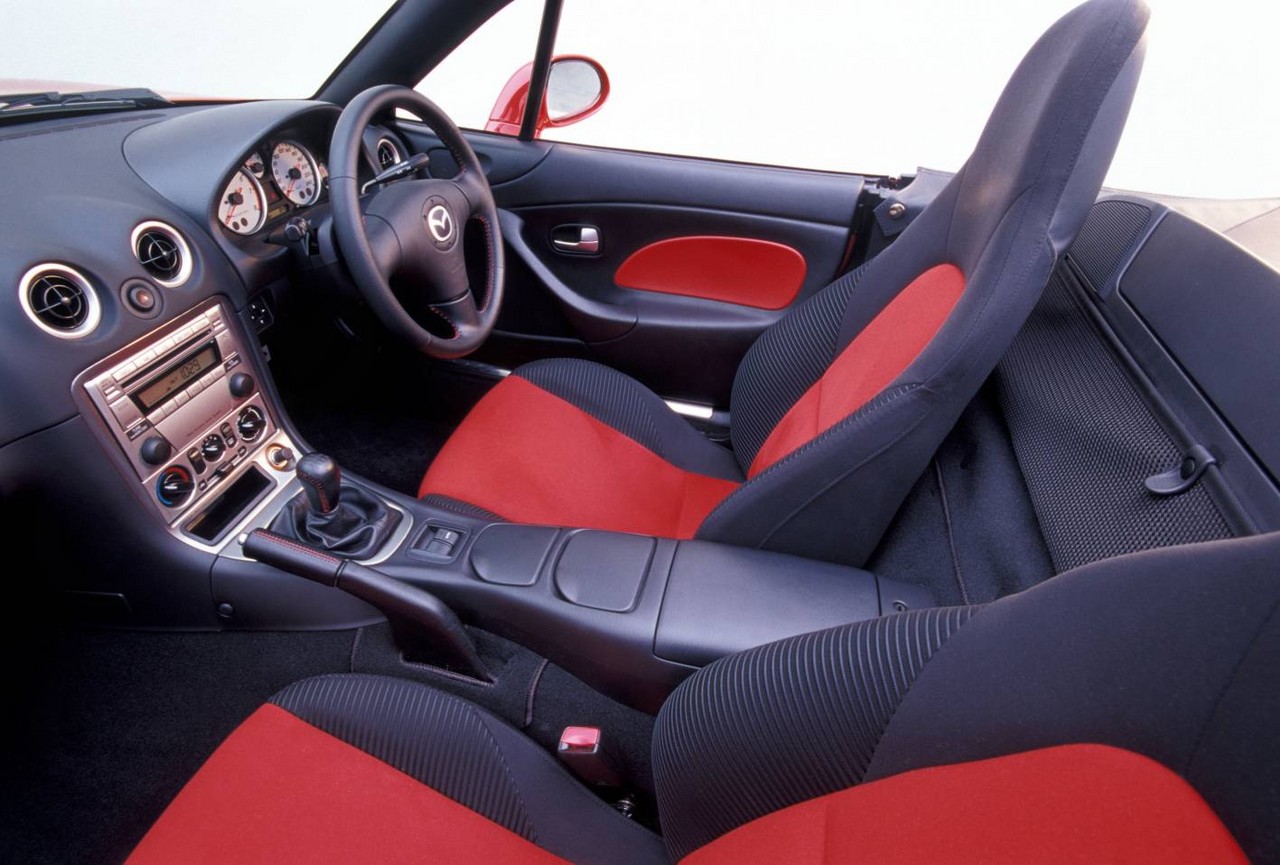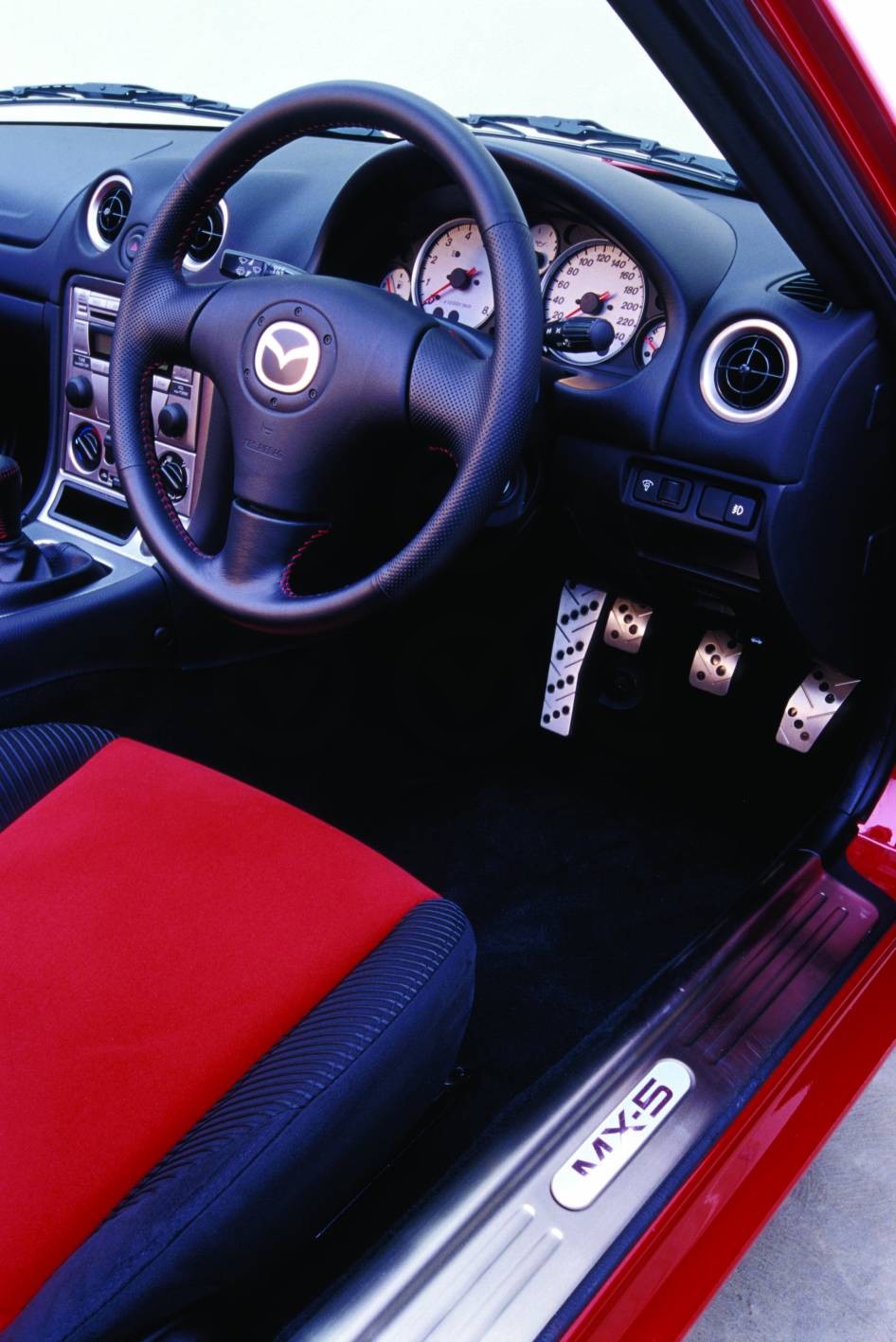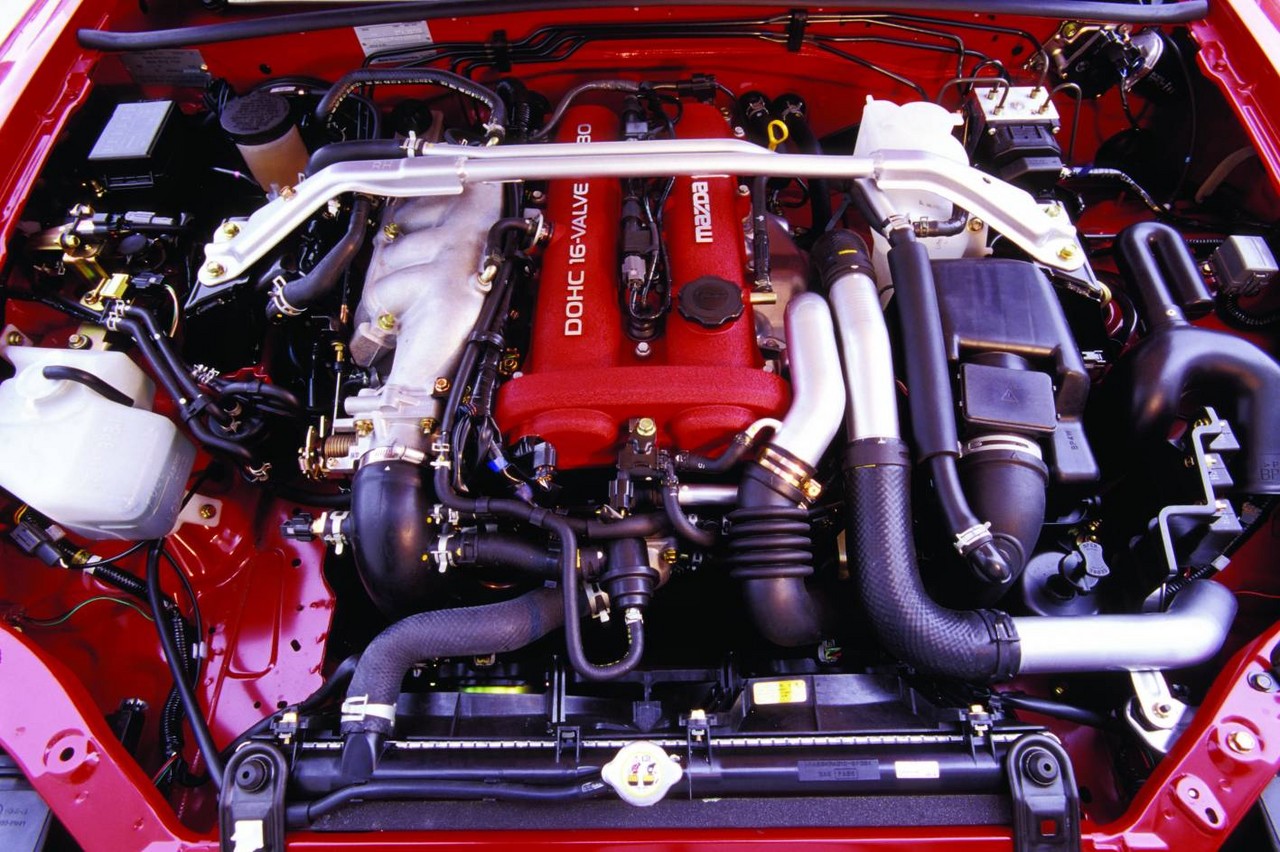
- Willing 1.8-litre petrol engines
- Lightweight, balanced chassis makes for impressive dynamics
- Accurate steering provides excellent feedback
- Responsive brakes
- Lack of low-rev response
- Suspension lacks low-speed compliance
- Cramped interior
- Driving position lacks adjustment
Review: Mazda NB.I MX-5 (1998-00)
Overview
Released in March 1998, the Mazda NB Series I (NB.I) MX-5 was a two-door convertible, available with a soft-top or removable fibre-reinforced plastic (FRP) hardtop. Manufactured in Hiroshima, Japan, the rear-wheel drive NB.I MX-5 was powered by a 1.8-litre four-cylinder petrol engine that was initially mated to either a four-speed automatic or five-speed manual transmission. Limited-run 10th Anniversary and Heritage editions, however, were fitted with a six-speed manual transmission (see table below).
1.8-litre BP-4W engine
The 1.8-litre BP-4W non-interference petrol engine had a cast iron block, an alloy cylinder head, double overhead camshafts (belt-driven) and four valves per cylinder. Compared to the 1.8-litre BP-ZE engine of the NA.II MX-5, the BP-4W engine had domed pistons for a higher compression ratio (9.5:1, previously 9.0:1), the intake camshaft was changed to a solid lifter design, the intake runners in the cylinder head were straightened, the intake manifold was repositioned and Mazda’s Variable Intake Control System (VICS) was introduced which used provided a long, narrow intake at low rpm for better swirl and a short, free-flowing manifold at high rpm for greater power.
Dimensions and body
Compared to its NA MX-5 predecessor, the NB MX-5 was 5 mm wider (at 1680 mm) and 5 mm lower (1225 mm), but its length and wheelbase were unchanged (at 3975 mm and 2265 mm, respectively). Greater torsional rigidity was also achieved due to thicker reinforcement panels and additional strengthening gussets. The NB MX-5 was fitted with a glass rear window (previously plastic) and windblocker as standard, while boot space increased by 40 per cent to 144 litres by relocating the spare wheel and battery under the floor.
Suspension
Like its NA predecessor, the NB MX-5 had independent double wishbone suspension front and rear, but with thicker front and rear anti-roll bars. Furthermore, front track was increased by 10 mm (to 1415 mm), a new hub carrier upright added 20 mm to the rear track (1440 mm) and rear suspension travel was increased by 10 mm to 100 mm.
| Engine | Edition | Trans. | Peak power | Peak torque | |
|---|---|---|---|---|---|
| NB.I MX-5 | 1.8-litre petrol I4 | N/A | 4sp auto, 5sp man. |
106 kW at 6500 rpm | 165 Nm at 4500 rpm |
| 10th Anniversary, Heritage |
6sp man. |
Safety equipment
Standard safety equipment for the NB.I MX-5 was limited to dual front airbags; the 10th Anniversary edition was also equipped with ABS.
Features
Standard features for the MX-5 included 15-inch alloy wheels, a four speaker sound system with a radio and cassette player, a leather-wrapped steering wheel, central locking, power mirrors and windows, a glass rear window, windblocker and an immobiliser.
1999 MX-5 10thAnniversary edition
In January 1999, the MX-5 10thAnniversary edition was released. Compared to the standard MX-5, the 10th Anniversary edition featured 15-inch polished alloy wheels, Bilstein sports suspension, strut tower bar, blue soft-top roof and tonneau cover, ‘Innocent Blue Mica’ paint finish, two-tone black and blue interior trim, blue suede-like seat panels, Nardi leather-wrapped steering wheel and gearshift, stainless steel scuff plates, chrome ringed instruments and carbon-fibre interior highlights.
2000 MX-5 Heritage edition
Released in February 2000, the Heritage edition was differentiated by its 15-inch polished alloy wheels, deep metallic burgundy paint finish (‘Art Vin’), leather seats, chrome ringed and white-faced instruments and woodgrain interior finishes for the Nardi steering wheel, gearshift, centre console and park brake.
Review: Mazda NB.II MX-5 (2000-02)
Overview
Released in October 2000, the NB Series II (NB.II) MX-5 introduced a new engine (see ‘1.8-litre BP-Z3 engine’, below), stiffer chassis and a six-speed manual transmission. In January 2002, the turbocharged MX-5 SP was released and a four-speed automatic transmission was introduced for the standard MX-5.
Compared to its NB.I predecessor, the NB.II MX-5 chassis received additional reinforcements with newly added truss members, improved body frame and cross members and an under-bonnet brace between the suspension towers. As a result of these changes, bending rigidity increased by 16 per cent and torsional rigidity by 22 per cent. The suspension was also revised with the introduction of Bilstein dampers which had additional valves for controlling rebound.
Visually, the NB.II MX-5 could be identified by its revised front bumper, slimmer headlights, fog lamps (incorporated into the air dam) and clear tail-lights. Inside, the steering wheel featured a Mazda logo, while the white-faced instruments had amber back lighting and chrome ring surrounds.
1.8-litre BP-Z3 engine
The 1.8-litre BP-Z3 engine had similar properties to the BP-4W engine but omitted VICS and introduced variable intake valve timing (Mazda’s Sequential Valve Timing, or S-VT) and a Variable Tumble Control System (VTCS). The compression ratio was also higher at 10.0:1, compared to 9.5:1 for the BP-4W.
| Variant | Engine | Trans. | Years | Peak power | Peak torque | |
|---|---|---|---|---|---|---|
| NB.II MX-5 | N/A | 1.8-litre petrol I4 | 6sp man. | 2000-02 | 113 kW at 7000 rpm | 181 Nm at 5000 rpm |
| 4sp auto | 2002 | 102 kW at 6500 rpm | 170 Nm at 5000 rpm | |||
| SP | 1.8-litre turbo petrol I4 | 6sp man. | 2002 | 157 kW at 6800 rpm | 289 Nm at 4600 rpm |
Safety equipment
Compared to its NB.I predecessor, safety equipment was improved with ABS standard across the range.
Euro NCAP crash testing
In Euro NCAP testing , the NB.II MX-5 received a four star adult occupant protection rating with a score of 25.09. In the frontal offset crash test, protection from serious chest and leg injury was marginal for the driver; in the side impact crash test, there was a slight risk of serious chest and abdomen injury.
Features
Standard features for the NB.II MX-5 were extended to include a CD player.
MX-5 SP (Special Performance)
In January 2002, the range was expanded with a turbocharged SP variant. The 1.8-litre BP-Z3 engine for the MX-5 SP was fitted with a water-cooled Garrett ball-bearing turbocharger (providing maximum boost pressure of 8.0 psi), an air-to-air intercooler and a Bosch blow-off valve; the compression ratio was unchanged at 10.0:1.
Other changes included a new intake, a purpose-cast nickel-alloy manifold, larger volume fuel injectors, a larger radiator, unique spark plugs, a reprogrammed ECU and big bore exhaust system. Despite the extensive modifications, the MX-5 SP was only 34 kg heavier – with a kerb weight of 1119 kg – than the naturally aspirated NB.II MX-5.
Visually, the MX-5 SP could be identified by its larger exhaust, stainless steel scuff plates, alloy air vent surrounds and polished alloy gear knob and fuel filler cap. Inside, the MX-5 SP featured a Nardi leather steering wheel and stainless steel scuff panels.
2002 MX-5 Titanium edition
In March 2002, a manual-only Titanium edition was released. Compared to the standard MX-5, the Titanium edition added a six-stack CD player, camel-coloured leather seats and door inserts, brushed alloy interior highlights and Titanium grey metallic paint finish.
Review: Mazda NB.III MX-5 (2002-03)
Overview
Released in October 2002, the NB Series III (NB.III) was a minor update for the MX-5 range, with the engines slightly detuned to comply with Euro III emission standards.
| Engine | Trans. | Peak power | Peak torque | |
|---|---|---|---|---|
| NB.III MX-5 | 1.8-litre petrol I4 | 4sp auto | 102 kW at 6500 rpm | 170 Nm at 5000 rpm |
| 6sp man. | 107 kW at 7000 rpm | 168 Nm at 5000 rpm |
Safety equipment
For the NB.III MX-5, safety equipment was enhanced with front seatbelt pretensioners and load limiters; the A-pillars were also reshaped for improved collision protection.
Features
The automatic and manual models were also further differentiated: while the automatic models were fitted with 15-inch alloy wheels, the manuals were fitted with 16-inch alloys and a front suspension strut tower bar.
2003 MX-5 Classic edition
In January 2003, a limited-run Classic edition was released; it was distinguished by its Cerrio Silver metallic paint, blue leather trim, blue soft top roof, six-stack CD player, two-tone blue/black Nardi steering wheel, two tone gearshift and park brake and aluminium-look interior finishes (for the centre panel, air vent bezels, gearbox shift plate, door handles and park brake).
Review: Mazda NB.IV (2003-05)
Overview
Released in November 2003, the NB Series IV (NB.IV) MX-5 introduced a number of minor updates; in 2004, the range was expanded with the introduction of a turbocharged SE variant.
| Variant | Engine | Trans. | Peak power | Peak torque | |
|---|---|---|---|---|---|
| NB.IV MX-5 | N/A | 1.8-litre petrol I4 | 4sp auto | 102 kW at 6500 rpm | 170 Nm at 5000 rpm |
| 6sp man. | 107 kW at 7000 rpm | 168 Nm at 5000 rpm | |||
| SE | 1.8-litre turbo petrol I4 | 6sp man. | 121 kW at 6000 rpm | 206 Nm at 4500 rpm |
Features
The NB.IV MX-5 featured new-look 16-inch alloy wheels for manual models and a larger wind deflector with two speakers (for a total of six). Inside, the dash featured an alloy finish, while there were also alloy highlights for the air vents, door handles and gearshift surround.
Mazda MX-5 SE
Released in March 2004, the turbocharged MX-5 SE featured 17-inch alloy wheels with 205/40 R17 80W tyres, stiffer suspension with Bilstein shock absorbers, torque-sensing limited slip differential, larger exhaust pipe, coloured brake calipers, six-stack CD player, seat fabrics with red inserts, drilled aluminium pedals, body kit (front spoiler with enlarged air intake and recessed fog lamps, boot spoiler, rear underbody spoiler), chrome exhaust tip and stainless steel scuff plates. Black leather trim (highlighted with red stitching) was optional.
The engine for the MX-5 SE had an air-to-air intercooler and a single-scroll turbocharger which provided maximum boost pressure of 7.25 psi (0.5 bar); the compression ratio was reduced to 9.5:1 (from 10.0:1). Other hardware changes for the MX-5 SE included a more efficient radiator, an upgraded clutch, propeller shaft and differential, and a harder rubber compound for the engine and differential mounts.
For the suspension, the coil springs were 20 per cent stiffer, ride height was reduced by 7 mm and thicker anti-roll bars were fitted (1 mm diameter increase for the front roll bar and 2 mm diameter increase for the rear roll bar). Furthermore, the MX-5 SE had a faster steering ratio which required 2.3 turns lock-to-lock, rather than the 2.7 turns of the standard MX-5.
Related links
